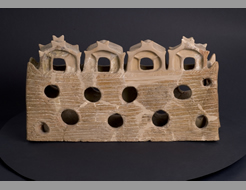|
||||||||||||||||||||||||||||||||
|
|
Museum of: Bucharest | |||||||||||||||||||||||||||||||
| Name of the artefact: Miniature sanctuary model | ||||||||||||||||||||||||||||||||
|
Sanctuary models, with different form and size, are
specific for the Neolithic civilization |
||||||||||||||||||||||||||||||||
|
WHERE IS IT AND MAIN
CHARACTERISTICS |
STATE |
|||||||||||||||||||||||||||||||
|
Department: |
Archaeology |
Preservation: |
Good | |||||||||||||||||||||||||||||
|
Inventory number: |
12156 |
Restauration: |
Restored | |||||||||||||||||||||||||||||
|
Name of the artefact: |
Miniature sanctuary model |
Completeness: |
Almost Complete | |||||||||||||||||||||||||||||
|
Object type: |
Other |
|||||||||||||||||||||||||||||||
|
Material: |
Clay |
|||||||||||||||||||||||||||||||
|
Methof of manufacture: |
Shaping, firing |
|||||||||||||||||||||||||||||||
|
Decoration
type: |
Incision |
|||||||||||||||||||||||||||||||
|
Distinctive mark: |
- |
|||||||||||||||||||||||||||||||
|
DIMENSIONS |
PERIOD OF USE |
|||||||||||||||||||||||||||||||
|
Length (mm): |
510 |
Epoque: |
Neolithic |
|||||||||||||||||||||||||||||
|
Heigth
(mm): |
242 |
Culture: |
Gumelniţa |
|||||||||||||||||||||||||||||
|
Diameter
(mm): |
- |
Period: |
Eneolithic |
|||||||||||||||||||||||||||||
|
Width (mm): |
130 |
Face: |
A2 |
|||||||||||||||||||||||||||||
|
Thickness (mm): |
- |
Absolute chronology: |
4500-4000 BC |
|||||||||||||||||||||||||||||
|
Weight
(g): |
- |
|||||||||||||||||||||||||||||||
DISCOVERY |
||||||||||||||||||||||||||||||||
|
Date: |
1968 |
Country: |
Romania |
|||||||||||||||||||||||||||||
|
District: |
Călăraşi |
Town hall affiliation: |
Căscioarele |
|||||||||||||||||||||||||||||
|
Village: |
Căscioarele |
Discovery findspot: |
Ostrovel |
|||||||||||||||||||||||||||||
|
Condition of discovery: |
Archaeological excavation |
Discovery type: |
Dwelling |
|||||||||||||||||||||||||||||
|
ANALYSES – DETERMINATIONS |
FILLED IN BY |
|||||||||||||||||||||||||||||||
|
Type: |
- |
Name: |
Radian Andreescu, Katia
Moldoveanu |
|||||||||||||||||||||||||||||
|
Laboratory: |
- |
Institution: |
Romanian National History
Museum |
|||||||||||||||||||||||||||||
|
No./Code: |
- |
Date: |
23/02/2005 |
|||||||||||||||||||||||||||||
|
DEEPENINGS |
||||||||||||||||||||||||||||||||
|
Morphology of the object: |
||||||||||||||||||||||||||||||||
|
This artefact made of grey-yellowish clay is probably a
miniature representation of a sanctuary. It consists of a hollow
rectangular base perforated by a range of holes. On the top, there are
four small houses, each of them having two entrances and being crowned
with some elements as horns on the gable and above the four corners.
|
||||||||||||||||||||||||||||||||
|
Decoration: |
||||||||||||||||||||||||||||||||
|
The base is decorated with ranges of horizontal
incisions. |
||||||||||||||||||||||||||||||||
|
Inscription: |
||||||||||||||||||||||||||||||||
|
- |
||||||||||||||||||||||||||||||||
|
Analogies: |
||||||||||||||||||||||||||||||||
|
In the Neolithic sites there were discovered several
sanctuary models, varying as shape and size. Some of them represent a
possible projection of a real sanctuary (as at Căscioarele), others
represent houses of different size, with wired elements as holes in the
walls and roof (as in the case of an artefact discovered at Sultana). In
other case is represented the interior of a house with a domestic scene,
as in the case of the model discovered at Popudnia, Ukraine, Cucuteni
culture. |
||||||||||||||||||||||||||||||||
|
Interpretation: |
||||||||||||||||||||||||||||||||
|
The artefact could represent a model of a real
sanctuary but it also could be an imaginary representation of a
tell-settlement. There weren’t discovered so far remains of such
construction in natural size. The ranges formed by three or four holes
were often used in the decoration of Gumelniţa civilization’s artefacts.
Anthropomorphic figurines have the ears perforated most often with three
or four holes. Bone figurines have a specific decoration made most of the
times of ranges of three or four small holes. All these suggest a symbolic
meaning of the holes ranges related with numerology. |
||||||||||||||||||||||||||||||||
|
Bibliography: |
||||||||||||||||||||||||||||||||
|
Author: Dumitrescu, H. Title: Un modèle de sanctuaire
découvert dans la station énéolitique de Căscioarele Periodical: Dacia
Volume: N.S. XII Place: Bucureşti Year: 1968 2. Author: Gimbutas, Marija
Title: The Gods and Goddesses of Old Europe Place: London Year:
1974 |
||||||||||||||||||||||||||||||||

